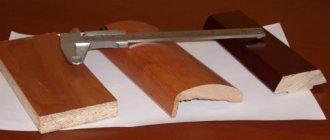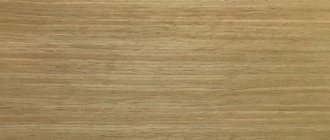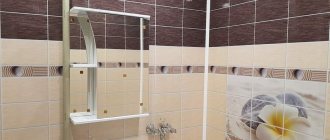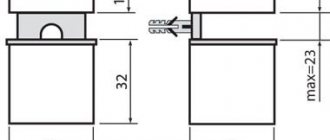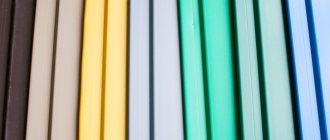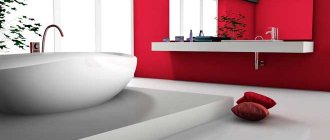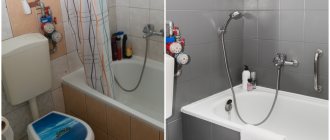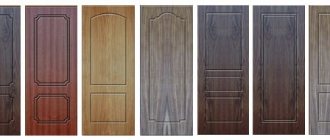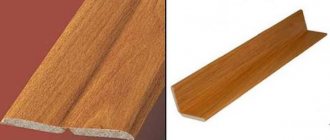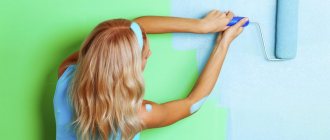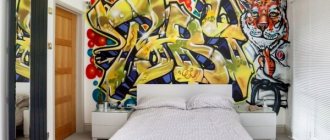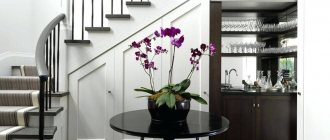What finishing material should you choose for bathroom walls? Most will answer that the best option is ceramic tiles. But this type of finishing is quite expensive. If the renovation budget is limited, it is worth choosing more affordable, but equally moisture-resistant materials. For example, MDF panels for the bathroom. Such repairs will cost much less, especially since the panels can be installed yourself.
MDF panels are a universal material that is suitable for renovation of any premises. Since the range of panels and their colors is very diverse, you can easily choose the material for finishing living rooms or office premises. And moisture resistance and resistance to temperature changes allows us to recommend MDF panels for the bathroom or kitchen.
What kind of material is this?
The manufacturing technology of MDF boards consists of pressing finely dispersed chips under conditions of high temperature and pressure. When wood is heated, an organic binder is released from it - lignin, that is, substances such as phenol and epoxy resins are not used in the production process.
Essentially, MDF is a medium-density fiberboard.
Sheathing nuances
In particular, PVC borders can be placed to seal the joint between the bathtub bowl and the wall.
Advice!
When you need to sheathe arched openings, or you have a large number of curves in the walls in the bathroom, you should give your preference to MDF panels for bathrooms with high moisture resistance.
When the interior design does not include arches and similar architectural solutions, it is better to give preference to PVC panels, since they are less picky in everyday care and are not afraid of accidental scratches.
Also interesting: Beautiful plastic ceiling in the bathroom with your own hands: all the subtleties of installation
A wall lined with PVC will look no worse than one with MDF. But, if MDF withstands an accidental blow and just “plays around,” then PVC, whose average impact resistance is lower, can break, completely ruining the impression of the bathroom design.
Advantages of MDF panels
Wall panels made from MDF have a number of undeniable advantages:
- Versatility. The material is suitable for finishing not only walls, but also ceilings. The panels can be used in almost any room.
- Attractive appearance. The variety of panel designs allows you to choose the material for interior design in any style.
- Simplest care. The walls on which the panels are installed do not require special care. To remove dust, it is enough to occasionally wipe the walls with a damp sponge, and to remove stains, you can use detergents.
Advice! It is necessary to take into account that the panels are moisture-resistant, but not waterproof, that is, they tolerate the action of humid air well, but do not tolerate direct contact with water, so you should not install them near the bathtub and sink.
- Simplest installation. To install the panels, you will not need to level the walls; even the old finish, provided that it holds tightly, does not need to be removed.
- Economical. The low cost of panels and components, as well as the ability to carry out repairs yourself, provides significant cost savings.
Kinds
Today, the domestic market offers a wide variety of all kinds of plastic products. Wall panels have several different variations for use in the bathroom. In fact, in terms of performance they are at the same level, however, in terms of functionality and appearance they differ quite sharply.
Leafy
Sheet models are very large elements. They differ from other brothers, first of all, in their size, but at the same time they are very easy to install. They are usually used with a pattern or image already applied. Sheet products are a high quality material that resists high levels of humidity and temperature changes.
Sheet panels
Typically, sheet panels are used for installation in the most difficult, from an operational point of view, areas. Often this is either a kitchen area or a bathroom, which allows the data in the room to be reliably protected. The main material used for the production of sheet products is fiberboard raw material. Eucalyptus additives containing natural resins, essential oils and other natural components are specially added to it.
This, together with protective impregnation, makes it possible to give sheet panels high strength and fire resistance. In addition, the production of sheet products from PVC material is allowed. In this case, it is a special sheet of medium-sized plastic. The resulting model is very convenient for transportation and installation. During installation, a very small number of joints and seams are obtained. This has a positive effect not only on the appearance of the shower, but also on its performance.
In addition, wall panels are treated with protective impregnations that protect them from the effects of aggressive environments that are formed when using cleaning products. It is also worth noting that special impregnations protect the material from additional load and scratches on the surface of the sheet. The service life of this product can vary from 10 to 15 years.
Rack and pinion
The next type of wall panels used indoors is slatted. These products are distinguished by high moisture-resistant properties in comparison with wooden or plastic lining. The domestic market offers a fairly extensive range of rack and pinion models. You can easily choose a wide variety of colors and shades of panels. This allows you to add a little originality and aesthetics to even a nondescript shower room.
Slatted panels
This material will fit perfectly into a room that is not distinguished by its large dimensions. Slatted products will create a special coziness and feeling of comfort in the space, by the way, visually enlarging it a little. Due to the visual effect, the height of the ceilings increases, and if you choose interesting patterns, you can get an original shower room. The structure is installed using special glue, as well as staples and screws.
Tiled
Finishing with panels is carried out differently depending on the models. For example, tile panels are laid in a checkerboard pattern. These panels are made from the most modern materials. The most commonly used raw materials are plastic and also have a square shape. They are laid on the surface of the wall in the shower room. In addition, these products successfully replace mosaic coatings, natural stone, wood, decorative plaster, and other materials.
Tile panels
Before laying the frame, it is necessary to thoroughly treat the surface. It should be well prepared for the installation of tile products, otherwise the fastenings will begin to loosen over time. This will lead to deformation of the structure, as well as the creation of favorable conditions for the proliferation of microorganisms.
Types of MDF panels
When choosing moisture-resistant MDF panels for bathroom walls, you should pay attention to the fact that this material is available in several versions:
- Rack panels. These are narrow (13-28 cm) and long (2.5 - 3.8 m) elements with a thickness of 8-14 mm. These bathroom panels are most often chosen.
- Tile panels. This material is produced in the form of squares, so it is convenient to lay out various patterns and designs from such panels. The sizes of the tiles can be different, most often there are squares with a side length from 30 to 98 cm.
- Sheet panels. These are large elements measuring 1.25 by 2.5 meters. The thickness of the sheets can be from 3 to 7 mm.
How effective are slabs made from finely dispersed fractions?
So, in order for water not to be absorbed into the material, it must have a very high density, and thanks to the dry pressing of very small particles of wood, this quality is most pronounced in MDF panels. In this case, production is carried out under the influence of high temperatures and using binders, which, when heated, impregnate the wood fractions. In particular, urea resins are used; they are the safest in terms of the release of formaldehyde, a volatile substance that is quite harmful to the body. In such resins combined with melamine, the formaldehyde content is negligible.
MDF boards for bathroom
As for density, it is possible to achieve values such as 600–800 kg/m2, due to which moisture simply does not find cavities between the fractions, which, moreover, are already saturated with a binder. Don’t forget about the natural connector lignin, which is released from wood fibers when heated. Thus, with a sufficient thickness of the slab, you can count on high strength and reliability of the material. Therefore, instead of expensive clinker tiles for the bathroom, you can get by with decorative MDF panels, although they can hardly be called cheap either. But taking into account the durability and almost complete waterproofness, the benefits of using such cladding are obvious.
Features of installation of MDF panels
Moisture-resistant wall panels are usually installed on a sheathing assembled from a metal profile.
Preparation of materials and tools
You should start by purchasing materials. How many panels will be needed? The calculation is not difficult, you need to measure the width of the room (since the panels are produced up to 3.8 meters long, they will fit in height to a room of any size) and find out the width of the panels. After simple calculations, you will know how many pieces will need to be purchased.
Finishing corners will be required for finishing. This part consists of two fiberboard strips, laid parallel and fastened on one side with a film in the color of the panels. Thanks to this design, the corners are universal; they can be bent both outward and inward.
Advice! Such corners are very convenient if you have to work with non-standard, that is, indirect angles.
To attach the panels to the frame, you will need small self-tapping screws (builders call them “bugs”, “fleas” or “seeds”). And to attach the profile to the wall you will need dowels. The sheathing will be constructed from a metal profile. In addition, you will need the following set of tools:
- Hammer.
- Screwdriver.
- Roulette.
- Level.
- Plumb.
- Pencil or marker.
Advice! If electrical wiring will run under the panels, then it will be necessary to purchase a special protective corrugation for the wires.
Preparing the walls
In principle, when renovating premises, no special preparation of the walls is required; you just need to remove the old coating that is falling off and remove the crumbling places in the plaster layer. But since the bathroom is a specific room, the requirements for renovation technology are somewhat different.
It is still recommended to remove the existing decorative coating in the bathroom. The fact is that it is under the tiles or wallpaper that there may be a “mycelium” of mold fungi. To destroy it, you need to remove the coating and treat the infected area with an antiseptic solution.
Next, you need to apply 2-3 layers of special antifungal primer to the walls. This protective measure will prevent the formation of mold and prevent premature destruction of the walls. If necessary, you can cover the walls with insulating material made from polyethylene foam.
Construction of sheathing
At the first stage, markings should be made, indicating the places where the profiles are attached. It must be remembered that if the panels are planned to be mounted parallel to the ceiling, then the profile should be positioned vertically and, accordingly, vice versa. According to the completed markings, the profile is attached, each time checking with a level that they are correctly positioned. The optimal profile spacing is 40 cm, maximum is 50.
Paneling
- Installation of an MDF panel for a bathroom starts from the corner of the room. It needs to be measured and cut to height, not forgetting to leave a gap of 2 mm.
- Place the panel against the wall, also 2 mm away from the corner, and secure it on both sides.
- All panels are connected according to the “groove-tenon” principle; the first panel is placed so that this “tenon” is directed into the corner. The panel is screwed to the frame slats using self-tapping screws.
Advice! It is advisable to make the holes for the screws in advance and countersink them for the caps.
- Self-tapping screws should be screwed at a distance of 10-15 mm from the edge of the panel strip. This is the optimal distance, since if you screw the screws into the very edge of the panel, it may crack, and if you step back too far, the corner will not cover the attachment point.
- From the side where the groove is located, the panel is fixed to the slats using clamps - fastening clips. The kleimer is put on the side of the groove that faces the wall and secured to the sheathing slats.
- The second and subsequent panels are easier to install, since they are simply inserted into the groove of the previous one, and on the opposite side, each panel is secured with clamps, as described above.
- It is extremely rare for the last panel to fit perfectly in width. Most likely, it will have to be cut to fit. The last panel is no longer fastened with clamps; like the first, it is screwed with self-tapping screws in the corner; the fastening point will then be covered with a corner.
- Universal corners are installed when all the walls are covered with panels. They are attached with glue. If it is necessary to join the corners, they are cut at an angle of 45 degrees; they are easy to cut; you can use a paint knife or metal scissors.
- To glue the corners, it is convenient to use “Liquid Nails”; the adhesive should not be applied in a too thick layer. First, you just need to attach the corner to the place where it is installed. This is done so that the glue is on both surfaces. Then, after waiting for 3-5 minutes, you need to press the corner firmly against the wall, since the strength of the gluing will depend on this.
- If, despite precautions, the adhesive composition comes out, you should not try to remove it immediately. The fact is that if you rub with a dry cloth, the glue will only smear, forming an unsightly stain. The best solution is to wait until the glue has completely hardened, and then try to carefully cut off the frozen drop with a knife.
So, moisture-resistant MDF panels for bathroom walls are an excellent finishing option that you can easily do yourself.
Preparing the base
So, if you decide to install the panels yourself, then, as mentioned above, this work is not difficult, but there are still some nuances and features. The first step is to prepare the base of the walls in the bathroom.
For this:
- Wallpaper, if any, should be torn off. In those places where they peel badly, you can leave them.
- Cover the surface with a primer (since the bathroom has very high humidity, in our case this is necessary). The primer will help prevent the appearance of mold and its spread.
Fiberboard as a budget option for covering walls
If this material is inferior in density to MDF, it is only slightly, and only because the fractions used in the manufacture of fiberboards are quite large. However, the use of synthetic resins, paraffin and rosin in combination with hot pressing under high pressure makes it possible to obtain moisture-resistant and, most importantly, durable panels. In a mixture of wood fibers, coniferous species sometimes predominate, which significantly increases the material’s resistance to water after pressing at high temperatures, when the resins are partially released from the fractions. To obtain a particularly durable class of panels, additional impregnation with pectol - tall oil - is used, which also increases moisture resistance.
conclusions
MDF boards for the bathroom are a universal material. Some manufacturers additionally cover panels or facades with polyvinyl chloride film, as a result they can achieve the effect of a laminated surface. Here is about laminated wall panels.
Thanks to this, slabs can be produced in any color or shade, up to a complete repetition of the structure and texture of natural wood .
Laminated wall panels for interior decoration are several times more expensive, not to mention 3D panels, which are the most expensive.
And at the same time, natural wood does not react well with moisture, it begins to deform, rot, and smell unpleasant, but laminated MDF panels do not absorb moisture, so they will last you quite a long time.
If you don’t know what furniture to choose for the bathroom, after reading this article you will certainly make the right choice in favor of high quality and affordable prices.
Fastening
In order to install the frame on which the panels themselves will be attached, special wooden slats are best suited. Due to the properties of the panels, namely their weight, the slats can easily support them. Fastened with dowels and nails. When doing work, you need to control everything with a level so that there is no tilting.
The MDF panels themselves are attached to these slats using clasps. These staples fit between the panels and are nailed in place with a regular nail. MDF panels are used exclusively for flat surfaces because they do not tend to bend. If you need to line a radius wall, then you should look for another material. MDF is also great for flat ceilings.
Advantages and disadvantages
Of course, every person dreams of making high-quality renovations in their apartment. However, good materials often have a high cost. When it comes to the bathroom, many people opt for MDF panels. This finishing material has an affordable price, but it is quite durable and can last for a long time. It is easy to install and mounting is not difficult. The panels are made from wood that has gone through certain stages of processing and are therefore environmentally friendly.
MDF panels can be called a popular finishing material for bathrooms. They are an excellent analogue to tiles. In addition, the material’s properties are not inferior to ceramics, while at the same time having a much lower cost.
Externally, these products look very attractive; they have a rectangular shape. There are no gaps around the edges when installed.
Such materials are very easy to process. They have excellent thermal insulation. It should also be noted that the range of models is quite wide, they can be chosen to suit every taste. They go well with other finishing materials and look good next to stone and tiles. As for the sizes, this material is very comfortable. The panels can be used in bathrooms of any size. They look equally impressive in both small and large rooms.
However, there are also disadvantages to MDF panels. This is completely normal, since materials that do not have absolutely any disadvantages simply do not exist. In addition, with careful operation, some of the troubles can be avoided. One can note a low level of impact resistance and susceptibility to mechanical stress, as a result of which scratches and abrasions may appear on the surface. MDF is also considered a fire hazardous material.
The panels are moisture resistant, their performance characteristics are quite high. As for the disadvantages, you need to try to mitigate the risk of their manifestation as much as possible. This means you should not use force, scratch the material with hard brushes, or keep open flame sources near it.
Installation without sheathing
If you need to save bathroom space, you can attach moisture-resistant panels directly to the surface. However, for this the walls must be perfectly smooth. The stages of work are as follows:
Preparation of tools and materials. In addition to MDF panels, the calculation of which is carried out according to the same principle as in the previous case, you will need glue (do not forget: it must also be moisture resistant), a tape measure, a plumb line, a level, putty and cement mortar for treating the walls. It is better to first keep the panels at room temperature for about two days, then cut them into pieces of the required length and make holes for lamps and sockets. It is advisable to treat all edges with sealant.
- Surface preparation. This stage must be taken very seriously: unevenness must be carefully eliminated in order to obtain smooth walls as a result. The surface is well cleaned, dried and primed.
- Facing. The adhesive composition should be applied using a spatula to the panels in thin strips at a distance of approximately 5-10 cm or in a zigzag pattern. Then the panels are applied to the wall and pressed. In this way, all the material is gradually assembled, which, after completion of the work, is wiped and treated with an antistatic agent.
Tip: when using adhesives, a problem that often arises is their excess. As a result, glue gets onto the surface of the slabs, but you can’t wipe it off right away: the paint may be damaged. It's better to wait until it hardens and cut off the excess with a knife.
Thus, decorating walls with MDF panels is an excellent and very simple way to get a magnificent bathroom that will delight you with its bright design for a long time.
